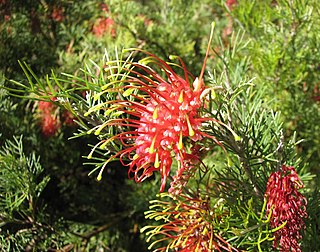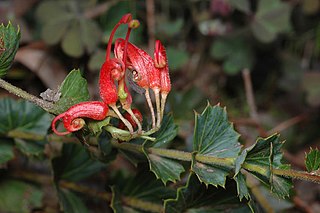
Grevillea, commonly known as spider flowers, is a genus of about 360 species of evergreen flowering plants in the family Proteaceae. Plants in the genus Grevillea are shrubs, rarely trees, with the leaves arranged alternately along the branches, the flowers zygomorphic, arranged in racemes at the ends of branchlets, and the fruit a follicle that splits down one side only, releasing one or two seeds.

Grevillea thelemanniana, the spider-net grevillea or hummingbird bush, is a small, spreading shrub endemic to Western Australia.

Grevillea mucronulata, also known as green spider flower or green grevillea, is a species of flowering plant of the family Proteaceae andt is endemic to New South Wales in Australia. Described by Robert Brown in 1810, it is found in open sclerophyll forest or woodland around the Sydney region and New South Wales south coast. It grows as a small bush to 3 m (9.8 ft) high and wide, with variable foliage and greenish flowers that appear over the cooler months from May to October. The flowers are attractive to birds.

Grevillea pilosa is a low growing shrub which is endemic to the south-west of Western Australia. It grows to between 0.4 and 1 metre in height and produce red or pink flowers between June and December in its native range.

Grevillea rhyolitica, also known as Deua grevillea, is a shrub which is endemic to south-eastern New South Wales in Australia. It grows to between 0.5 and 2 metres in height.

Grevillea pimeleoides is a shrub which is endemic to the south west region of Western Australia.

Grevillea pinaster is a shrub in the family Proteaceae. It is endemic to south-western Western Australia.

Grevillea argyrophylla, the silvery-leaved grevillea, is a species of flowering plant in the family Proteaceae and is endemic to the south-west of Western Australia. It is an erect, sometimes low-lying shrub with egg-shaped leaves with the narrower end towards the base, and white flowers, sometimes tinged with pink.

Grevillea pteridifolia is a species of Grevillea native to Australia. Common names include silky grevillea, Darwin silky oak, ferny-leaved silky oak, fern-leaved grevillea, golden grevillea, golden tree and golden parrot tree. It occurs in Western Australia, Northern Territory, and Queensland.

Grevillea infundibularis, commonly known as fan-leaf grevillea, is a species of flowering plant in the family Proteaceae and is endemic to a restricted area in the south of Western Australia. It is a spreading to low-lying shrub with egg-shaped to hemispherical leaves and clusters of four to eight bright red flowers.

Grevillea aspera, commonly known as the rough grevillea, is a species of flowering plant in the family Proteaceae and is endemic to Australia, occurring mainly in South Australia. It is low, spreading to erect shrub with oblong to egg-shaped leaves with the narrower end towards the base, and pinkish to red and cream-coloured, green, yellow or white flowers.

Grevillea helmsiae, commonly known as Helms' grevillea, is a species of flowering plant in the family Proteaceae and is endemic to Queensland. It is a shrub or tree with elliptic to narrowly egg-shaped leaves with the narrower end towards the base and small clusters of white to cream-coloured flowers with a green style.
Grevillea calcicola is a species of flowering plant in the family Proteaceae and is endemic to the north-west of Western Australia. It is a much-branched shrub with pinnatisect leaves with linear lobes, and off-white to cream-coloured flowers.
Grevillea eremophila is a species of flowering plant in the family Proteaceae and is endemic to the south-west of Western Australia. It is an erect shrub with leathery, linear to narrowly egg-shaped leaves with the narrower end towards the base, and creamy-white flowers.

Grevillea fistulosa, commonly known as Barrens grevillea or Mount Barren Grevillea, is a species of flowering plant in the family Proteaceae and is endemic to the Fitzgerald River National Park in the south-west of Western Australia. It is an erect shrub with narrowly egg-shaped to broadly linear leaves and clusters of orange-red to scarlet flowers.
Grevillea polyacida is a species of plant in the protea family that is endemic to Australia.

Grevillea pungens, also known as flame grevillea, is a species of plant in the protea family that is endemic to Australia. The specific epithet pungens refers to the sharply spiked leaves.
Grevillea neorigida is a species of plant in the protea family that is endemic to Australia. The specific epithet rigida (“stiff”) refers to the stiffness of the leaves.
Grevillea saxicola is a species of plant in the protea family that is endemic to Australia. The specific epithet saxicola refers to the species’ habitat.
Grevillea sphacelata, also known as the grey spider flower, is a species of plant in the protea family that is endemic to Australia. The specific epithet sphacelata comes from the Latin for “withered”, with reference to the appearance of the flowers.













